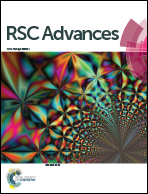Elaborating piperazinyl-furopyrimidine based scaffolds as phosphoinositol-3-kinase enzyme alpha (PI3Kα) inhibitors to combat pancreatic cancer†
Abstract
Phosphoinositol-3-kinase enzyme (PI3K) plays a crucial role in driving oncogenic growth in various mammalian cells, particularly pancreatic cells. In the current study a series of novel furo[2,3-d]pyrimidine based-compounds were designed and synthesized as potential PI3K-α inhibitors. In accordance to the structure–activity relationship (SAR) studies of known PI3K-α inhibitors, different linkers including amide, urea and ether were attached to a piperazinyl furo[2,3-d]pyrimidine core. The synthesized compounds that revealed moderate PI3K-α inhibitory activity were tested for their anti-proliferative activities against pancreatic carcinoma on the PANC-1 cell line. Compounds 7b and 8a showed the highest anti-proliferative activity with IC50 values of 4.5 μM and 6 μM, respectively and relatively, the best in vitro PI3K inhibition ability within the newly synthesized compounds. Additionally, all the newly synthesized final compounds were tested on 60 human cancer cell lines. A docking study was carried out on the PI3K-α active site showing a comparable binding mode to that of FDA approved PI3K-α inhibitors. These newly discovered lipid kinase inhibitors could be considered as potential candidates for the development of new targeted anticancer agents.



 Please wait while we load your content...
Please wait while we load your content...